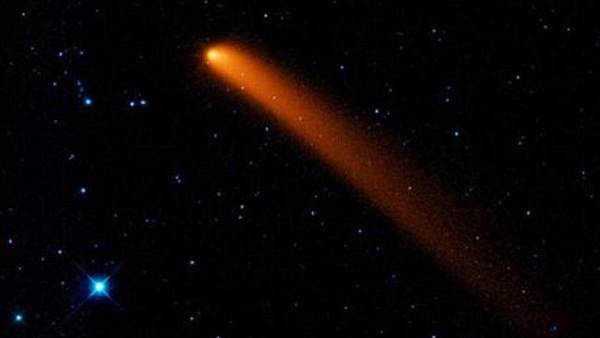Huge New Planet (Brown Dwarf?) Discovered in Our Solar System - Tyche Echoes of Planet X or "Nibiru"
Source: dailymail.co.uk
Largest planet in the solar system could be about to be discovered - and it's up to four times the size of Jupiter
Scientists believe they may have found a new planet in the far reaches of the solar system, up to four times the mass of Jupiter.
Its orbit would be thousands of times further from the Sun than the Earth's - which could explain why it has so far remained undiscovered.
Data which could prove the existence of Tyche, a gas giant in the outer Oort Cloud, is set to be released later this year - although some believe proof has already been garnered by Nasa with its pace telescope, Wise, and is waiting to be pored over.
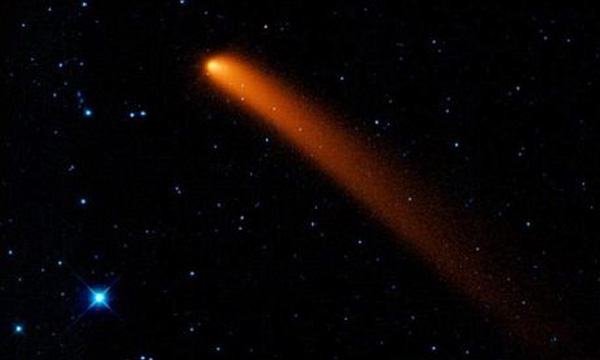
A new world? Astronomers believe a huge gas giant may be within the remote Oort Cloud region
Prof Daniel Whitmire from the University of Louisiana at Lafayette believes the data may prove Tyche's existence within two years.
He told the Independent: 'If it does, [fellow astrophysicist Prof John Matese] and I will be doing cartwheels. And that's not easy at our age.'
He added he believes it will mainly be made of hydrogen and helium, with an atmosphere like Jupiter's, with spots and rings and clouds, adding: 'You'd also expect it to have moons. All the outer planets have them.'
He believes the planet is so huge, it will ahve a raised temperature left from its formation that will make it far higher than others, such as Pluto, at -73C, as 'it takes an object this size a long time to cool off'.
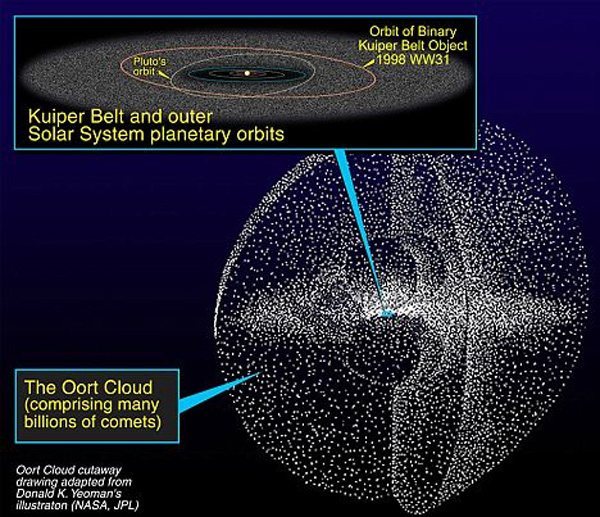
Isolated: The Oort Cloud, where Tyche is believed to be, is a sphere with a radius of one light year
He and Prof Matese first suggested Tyche existed because of the angle comets were arriving, with a fifth of the expected number since 1898 entering higher than expected.
However, Tyche - if it exists - should also dislodge comets closer to home, from the inner Oort Cloud, but they have not been seen.
If confirmed, the status and name of the new planet - which would become the ninth and potentially the largest - would then have to be agreed by the International Astronomical Union.
Currently named Tyche, from the Greek goddess that governed the destiny of a city, its name may have to change, as it originated from a theory which has now been largely abandoned.
Source: dailymail.co.uk
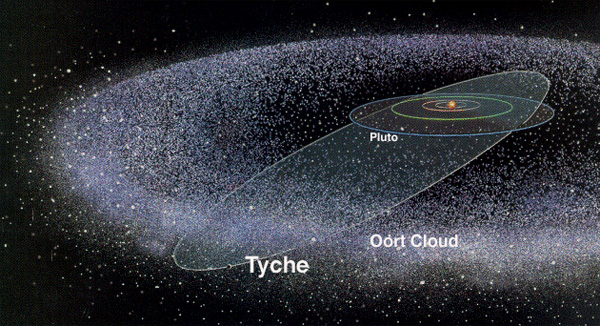
NASA scientists answer questions about 'Tyche' claims
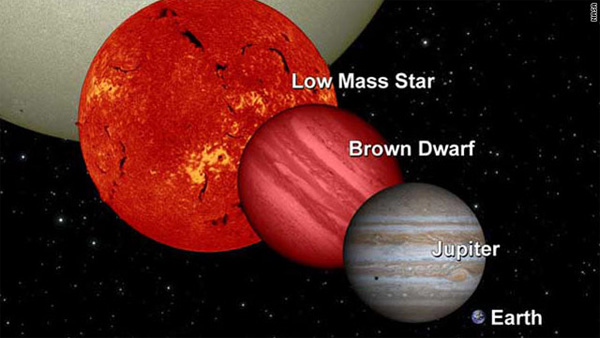
From: digitaljournal.com
Scientists from NASA's Jet Propulsion Laboratory have released comprehensive answers relating to a recent proposal by astrophysicists John Matese and Daniel Whitmire about the existence of a large planet in the outer part of the solar system.
The JPL statement follows recent reports about the proposals by Matese and Whitmore that were published in the November 2010 edition of the scientific journal Icarus. They had proposed the existence of a binary companion to our sun, larger than Jupiter, in the long-hypothesized Oort cloud - a distant repository of small icy bodies at the edge of our solar system. The researchers used the name "Tyche" for the hypothetical planet.
The NASA statement explains that the Matese/Whitmore paper argues that evidence for the planet would have been recorded by the Wide-field Infrared Survey Explorer (WISE) .
WISE is a NASA mission, launched in December 2009, which scanned the entire celestial sky at four infrared wavelengths about 1.5 times. It captured more than 2.7 million images of objects in space, ranging from faraway galaxies to asteroids and comets relatively close to Earth. Recently, WISE completed an extended mission, allowing it to finish a complete scan of the asteroid belt, and two complete scans of the more distant universe, in two infrared bands. So far, the mission's discoveries of previously unknown objects include an ultra-cold star or brown dwarf, 20 comets, 134 near-Earth objects (NEOs), and more than 33,000 asteroids in the main belt between Mars and Jupiter.
FAQs
The informatiove NASA/JPL/Caltech statement included answers to a number of frequently asked questions about the topic.
Q: When could data from WISE confirm or rule out the existence of the hypothesized planet Tyche?
A: It is too early to know whether WISE data confirms or rules out a large object in the Oort cloud. Analysis over the next couple of years will be needed to determine if WISE has actually detected such a world or not. The first 14 weeks of data, being released in April 2011, are unlikely to be sufficient. The full survey, scheduled for release in March 2012, should provide greater insight. Once the WISE data are fully processed, released and analyzed, the Tyche hypothesis that Matese and Whitmire propose will be tested.
Q: Is it a certainty that WISE would have observed such a planet if it exists?
A: It is likely but not a foregone conclusion that WISE could confirm whether or not Tyche exists. Since WISE surveyed the whole sky once, then covered the entire sky again in two of its infrared bands six months later, WISE would see a change in the apparent position of a large planet body in the Oort cloud over the six-month period. The two bands used in the second sky coverage were designed to identify very small, cold stars (or brown dwarfs) -- which are much like planets larger than Jupiter, as Tyche is hypothesized to be.
Q: If Tyche does exist, why would it have taken so long to find another planet in our solar system?
A: Tyche would be too cold and faint for a visible light telescope to identify. Sensitive infrared telescopes could pick up the glow from such an object, if they looked in the right direction. WISE is a sensitive infrared telescope that looks in all directions.
Q: Why is the hypothesized object dubbed "Tyche," and why choose a Greek name when the names of other planets derive from Roman mythology?
A: In the 1980s, a different companion to the sun was hypothesized. That object, named for the Greek goddess "Nemesis," was proposed to explain periodic mass extinctions on the Earth. Nemesis would have followed a highly elliptical orbit, perturbing comets in the Oort Cloud roughly every 26 million years and sending a shower of comets toward the inner solar system. Some of these comets would have slammed into Earth, causing catastrophic results to life. Recent scientific analysis no longer supports the idea that extinctions on Earth happen at regular, repeating intervals. Thus, the Nemesis hypothesis is no longer needed. However, it is still possible that the sun could have a distant, unseen companion in a more circular orbit with a period of a few million years -- one that would not cause devastating effects to terrestrial life. To distinguish this object from the malevolent "Nemesis," astronomers chose the name of Nemesis's benevolent sister in Greek mythology, "Tyche."
More about WISE:
Following its successful survey, WISE was put into hibernation in February 2011. Analysis of WISE data continues. A preliminary public release of the first 14 weeks of data is planned for April 2011, and the final release of the full survey is planned for March 2012.
JPL manages and operates the Wide-field Infrared Survey Explorer for NASA's Science Mission Directorate, Washington. The principal investigator, Edward Wright, is at UCLA. Science operations and data processing take place at the Infrared Processing and Analysis Center at the California Institute of Technology in Pasadena (Caltech). Caltech manages JPL for NASA.
More information is available online at:
http://www.nasa.gov/wise
http://wise.astro.ucla.edu
http://www.jpl.nasa.gov/wise
Source: digitaljournal.com
NASA Shuts Down Prolific Sky-Mapping Space Telescope WISE (Why?)
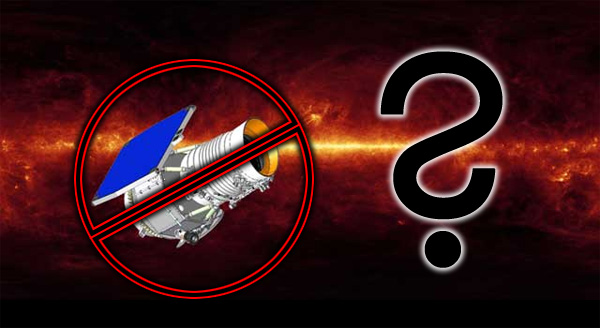
From: space.com
A prolific sky-mapping telescope that has spent more than a year scanning the heavens for asteroids, comets and other cosmic objects received its last command today (Feb. 17).
NASA shut down its WISE spacecraft – short for Wide-field Infrared Survey Explorer – at 3:00 p.m. EST (2000 UTC) today. The mission's principal investigator, Ned Wright of the University of California in Los Angeles, sent the final command to the now-hibernating spacecraft, according to an update from the WISE mission's official Twitter account.
"The WISE spacecraft will remain in hibernation without ground contacts awaiting possible future use," NASA officials said via Twitter.
WISE launched on Dec. 14, 2009 to begin a 10-month mission to collect data to be stitched together into a composite map of the entire sky. The spacecraft surveyed the cosmos in infrared light, which allowed it to peer through dense layers of dust to capture stunning space photos of previously unseen objects in unprecedented detail.
In addition to spotting asteroids and comets, the $320 million space telescope is designed to detect the faint glow of distant objects, such as strangely cool brown dwarf stars.
Over the course of its mission, WISE scanned the sky 1 1/2 times, taking about 1.8 million images of asteroids, stars and galaxies. The spacecraft also spotted 19 previously unseen comets and more than 33,500 asteroids, including 120 near-Earth objects, which are objects with orbits that pass relatively close to Earth's own orbit around the sun.
In late September 2010, WISE ran out of the coolant needed to chill its infrared detectors.
The observatory then began an extended mission, dubbed the NEOWISE Post-Cryogenic Mission. Without coolant to prevent its instruments from warming up, WISE operated on two of its four detectors, training its eyes on objects within our solar system.
Since the spacecraft and telescope were in good condition prior to mission's end, Wright proposed a three-month extension in order to complete the second half of the observatory's second sky survey. In May 2010, a NASA panel advised against the extension, however, which would have added $6.5 million to the program's price tag.
After WISE's coolant ran out, mission scientists came up with an alternative plan – the NEOWISE mission – to seek out near-Earth asteroids. That mission extension cost substantially less, about $400,000, NASA officials have said
Source: space.com
NASA Have known about this for some time: Mystery Heavenly Body Discovered (1983)
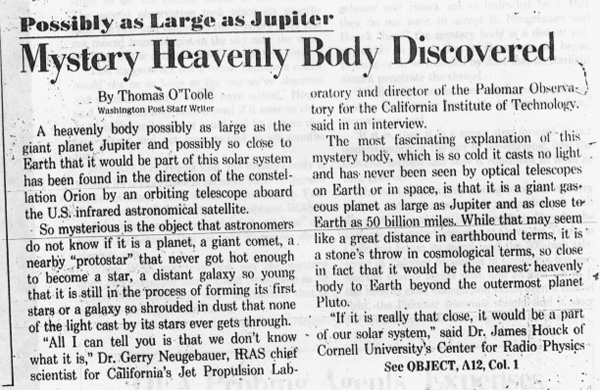
From 31 December 1983 Washington Post
A heavenly body possibly as large as the giant planet Jupiter and possibly so close to Earth that it would be part of this solar system has been found in the direction of the constellation Orion by an orbiting telescope aboard the U.S. infrared astronomical satellite. So mysterious is the object that astronomers do not know if it is a planet, a giant comet, a nearby “protostar” that never got hot enough to become a star, a distant galaxy so young that it is still in the process of forming its first stars or a galaxy so shrouded in dust that none of the light cast by its stars ever gets through. “All I can tell you is that we don’t know what it is,” Dr. Gerry Neugebauer, IRAS chief scientist for California’s Jet Propulsion Laboratory and director of the Palomar Observatory for the California Institute of Technology said in an interview.
The most fascinating explanation of this mystery body, which is so cold it casts no light and has never been seen by optical telescopes on Earth or in space, is that it is a giant gaseous planet, as large as Jupiter and as close to Earth as 50 billion miles. While that may seem like a great distance in earthbound terms, it is a stone’s throw in cosmological terms, so close in fact that it would be the nearest heavenly body to Earth beyond the outermost planet Pluto. “If it is really that close, it would be a part of our solar system,” said Dr. James Houck of Cornell University’s Center for Radio Physics and Space Research and a member of the IRAS science team. “If it is that close, I don’t know how the world’s planetary scientists would even begin to classify it.”
The mystery body was seen twice by the infrared satellite as it scanned the northern sky from last January to November, when the satellite ran out of the supercold helium that allowed its telescope to see the coldest bodies in the heavens. The second observation took place six months after the first and suggested the mystery body had not moved from its spot in the sky near the western edge of the constellation Orion in that time. “This suggests it’s not a comet because a comet would not be as large as the one we’ve observed and a comet would probably have moved,” Houck said. “A planet may have moved if it were as close as 50 billion miles but it could still be a more distant planet and not have moved in six months time.
Whatever it is, Houck said, the mystery body is so cold its temperature is no more than 40 degrees above “absolute” zero, which is 459 degrees Fahrenheit below zero. The telescope aboard IRAS is cooled so low and is so sensitive it can “see” objects in the heavens that are only 20 degrees above absolute zero. When IRAS scientists first saw the mystery body and calculated that it could be as close as 50 billion miles, there was some speculation that it might be moving toward Earth. “It’s not incoming mail,” Cal Tech’s Neugebauer said. “I want to douse that idea with as much cold water as I can.”
From: Washington Post
Red Ice Radio
Marshall Masters - The Kolbrin and Ancient Records of Planet X
Lucus - The Destroyer Star & The Future of Mankind
Rens van der Sluijs - Plasma Mythology & The Axis Mundi
Andy Lloyd - Dark Star, Evidence for Planet X
Joseph P Farrell - Cosmic War, Interplanetary Warfare & Mesopotamian Mythology
Michael S. Heiser - Zecharia Sitchin is Wrong, Sumerian Writings & Nibiru
